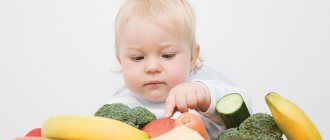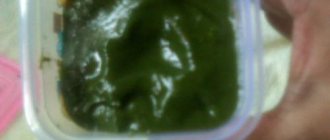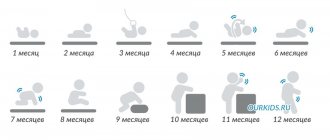Rules for creating a menu for a 10-month-old baby
In order to prepare a menu for your baby that includes healthy food that could replenish the body with the necessary elements, it is important to take into account the developmental characteristics at this age.
- At 10 months, almost every toddler already has several teeth, so the mother no longer needs to turn food into a homogeneous mass, but can offer a menu of dishes that contain small pieces of vegetables or other products. Such food will bring much more benefits to the child's body.
- It is also important to develop the chewing reflex, so it is worth offering food that needs to be picked up with your hands: small pieces of vegetables or fruits, meatballs, small pieces of meat or bread.
- At this age, you can already introduce your child to a spoon and invite him to eat from a plate on his own. This will have a positive effect on the development of the nervous system.
- The menu should consist of fresh dishes, i.e. prepared immediately before feeding. It is better to steam, boil or stew food.
- It is also important to ensure that the food is warm; hot or too cold food can harm the baby.
What to do to ensure that your child develops correctly
As always, at this stage, a lot depends on your actions in the growth and development of the baby. Here are some tips:
- Place durable, safe toys in the bottom drawer of your closet. The baby will be very happy when he discovers them while exploring the house, and this will have a positive effect on his self-confidence.
- As your child learns to stand up, he may become interested in stairs. If you have stairs at home, install special guards. However, you can allow your baby to climb to the lowest step under your supervision. It is necessary to stand below directly behind him.
- Show your child what gestures accompany the words "bye-bye", "yes" and "no", that is, show him how to wave goodbye, nod or shake his head to the side.
- Experts do not recommend using walkers. These devices are unsafe and discourage the child from walking independently. It’s better to buy him a stationary chair for support, a play set or a car with a handrail that you can hold on to and push it in front of you.
- It is not at all necessary to buy expensive toys for a ten-month-old baby. A child at this age is interested in empty boxes, egg cartons or even inserts for toilet paper rolls, in general, anything that bends, breaks and twists. In the store, you should give preference to a large doll or puppet, a toy phone, or a game box with keys that squeak, move, or open when pressed. Such toys develop motor skills and coordination of movements.
Sample menu at 10 months
A 10 month old baby's diet is as follows: he or she should eat 5 times a day, i.e. 3 main meals and 2 snacks. In general, a sample menu for each day can be presented as follows:
- For breakfast (7.00-8.00) you can offer your baby porridge, dairy or dairy-free, and some fruit or fruit puree.
- For second breakfast (10.00-11.00), cottage cheese and mother's milk (or formula if the child is on formula nutrition) are perfect.
- For lunch (14.00-15.00) you can offer a child aged 10 months a menu that includes vegetables and meat. These can be various vegetable soups and meat puree. You can also give some juice as a sweet dessert.
- For an afternoon snack (18.00-19.00) fruit and breast milk or a little mixture are suitable.
- Dinner (21.00-22.00) is recommended to be not very dense, but nutritious, otherwise the child will be capricious and unlikely to fall asleep because he will be hungry. Vegetables (stewed or mashed), porridge (dairy-free) and some meat may be suitable here. If the child doesn’t really want to eat in the evening, but still sleeps peacefully, you can give the baby kefir or a little yogurt instead of the suggested options. As a rule, such a dinner is formed in children closer to 1 year.
This is an approximate version of what a child should eat at 10 months, and each mother has the right to swap the proposed options and give them in the order that the little one likes best.
Features of the diet at 10 months of age
A child’s diet at 10 months is supplemented with new foods that are necessary to saturate the body with important microelements and vitamins.
At 10 months the child should eat:
- Vegetables. The very first vegetables that a baby gets acquainted with are: zucchini, cauliflower, broccoli, Brussels sprouts, carrots, pumpkin, potatoes. These are the least allergenic and most useful products after 6 months of a baby’s life. Then add greens (dill, parsley), onions, and green peas. It is better to steam or boil vegetables. They can be served separately, as an assortment or in combination with porridges and soups.
- Cereals. At the beginning of complementary feeding, the baby is introduced to rice, buckwheat or corn porridge. By the age of 10 months, oatmeal and pearl barley are added to the list. You can prepare cereal separately in combination with vegetables, meat, add it to soups or cook it in milk. Cereals are an essential component of a baby’s diet, as they saturate the body with the necessary carbohydrates and proteins.
- Meat. Before the first year of life, a child should know about such types of meat as chicken, rabbit, turkey, veal and lean pork. Then you can get acquainted with by-products, such as liver and heart. Meat must be included in the diet, since protein ensures the growth and development of a young body. It is better to cook meat dishes steamed in the form of cutlets, meatballs, or separately boiled.
- Fish. Fish dishes should be served on the children's table only after familiarization with meat. This is approximately 9-10 months. The first to be used are hake, pollock, and cod. The fish also needs to be steamed or boiled, checking as carefully as possible for the absence of bones. It is advisable to pamper your child with fish dishes at least 2 times a week.
- Fruits. At 10 months, the child should already be eating apples, pears, bananas, plums, and currants. It is important not to rush to give red berries and exotic fruits, as they can cause allergies. Fruits should be on the menu every day, because the fiber and carbohydrates they contain improve the functioning of the stomach and intestines and promote better absorption of beneficial vitamins and minerals.
- Dairy products. Cottage cheese, kefir or yogurt can be given from 6 months. These should be exclusively natural, fresh products from the store, or prepared at home using starter cultures. These dairy treats should be given to your child as a snack. Fermented milk products have a beneficial effect on the growth and strengthening of bones, as well as on balancing the intestinal microflora.
- Liquid. If the baby is already 10 months old, then in addition to breast milk he should drink distilled water, juice, compote, and jelly. Dried fruits (from apples, pears, apricots, plums) are well suited for making compotes; juices should only be natural without sugar, but preferably in a diluted form.
What additional products are introduced?
To ensure the proper development of the child’s body, it is necessary to dilute the diet with new foods. After 10 months, vegetables should be given to the child to try white cabbage, spinach, cucumber, and beets. From cereals, wheat and semolina porridge are added to the diet. It is worth noting that semolina is quite allergenic and promotes weight gain. Therefore, you should start using it based on the child’s tendency to allergies and his weight. After the age of 10 months, you can supplement the child’s nutrition with river fish, such as carp, river perch, and trout. At this age, you can try giving raspberries, strawberries, cherries, kiwi, and watermelon as fruits.
Some mothers are worried about what to feed their baby at 10 months if he is bottle-fed. There are no differences in the procedure for introducing complementary foods between natural and artificial feeding. The only thing is that you can start introducing new products to a baby who is fed an adapted milk formula a month earlier.
The menu of a 10 month old baby includes many basic and additional products.
Dosages and volumes
Regardless of whether the baby received mother’s milk or formula, the volume of food and complementary feeding is practically no different. To correctly calculate how much he should eat, you need to know the child’s weight and divide it by 9.
On average, a child at 10 months weighs about 9-10 kg, so he should eat about 1 kg per day. To provide the child’s body with the necessary substances, the following approximate amount of products that make up the complementary feeding menu is required:
| Vegetables or vegetable puree | 200 g |
| Dairy-free or milk porridges | 200 g |
| Meat or meat puree | 80 g |
| Butter | 6 g |
| Bread (white) | 15 g |
| Fish or fish puree | 15 g |
| Fruit or fruit puree | 100 g |
| Biscuits or crackers | 10 g |
| Vegetable oil | 6 g |
| Cottage cheese | 50 g |
| Dairy products | 180 g |
| Fruit juice | 50 g |
Sample menu table for the week
In order to correctly calculate the necessary products and make the child’s diet more balanced, consider the approximate composition of the menu for the week in the table.
Table of an approximate menu for a child aged 10 months for a week:
| 1 breakfast | 2 breakfast | Dinner | 1 dinner | 2 dinner | |
| Mon | Breast milk or formula | Milk buckwheat porridge, fruit, tea | Vegetable soup, mashed potatoes with cutlet, compote | Curd casserole, jelly | Breast milk or formula |
| VT | Breast milk or formula | Milk rice porridge, fruit, jelly | Pumpkin puree soup, carrot and potato puree, steamed fish, juice | Fruit puree, kefir, cookies | Breast milk or formula |
| SR | Breast milk or formula | Curd pudding, boiled yolk, juice | Soup with meat broth, zucchini and pumpkin puree, steamed meatball, compote | Vegetable puree, jelly, cookies | Breast milk or formula |
| Thu | Breast milk or formula | Milk corn porridge, fruit, fruit drink | Chicken broth, mashed potatoes with cutlet, tea | Cottage cheese with fruit, jelly | Kefir |
| PT | Breast milk or formula | Vermicelli with milk, jelly | Buckwheat soup with meat broth, vegetable puree, steamed fish, juice | Yogurt, fruit puree, cookies | Breast milk or formula |
| SB | Breast milk or formula | Milk buckwheat porridge, herbal tea | Pumpkin puree soup, boiled vermicelli, boiled meat, juice | Milk porridge, compote | Breast milk or formula |
| Sun | Breast milk or formula | Boiled vermicelli, boiled yolk, fruit | Rice soup with meat broth, mashed potatoes and pumpkin, cutlet, compote | Vegetable puree, cottage cheese, tea | Kefir |
Important! This table indicates the approximate composition of the diet and is not binding. It is important to take into account the baby’s physical condition, weight and his tendency to allergies.
How much should a child eat?
The consumption rate depends on the child’s age, physical condition, and weight. But there is a formula by which you can determine the daily intake, depending on the baby’s weight. So, the child’s weight should be divided by 9. This will be the amount of food that should be limited to per day. So, since a 10 month old baby weighs on average 8-10 kilograms. Then the daily norm for him will be 1000-1250 grams. If divided into 5 doses, you will get approximately 200-250 grams per feeding. This is what mothers who don’t know how much food to prepare at a time should take as a starting point.
It is necessary to understand that certain products also have restrictions on the amount of consumption per day. So, a 10-month-old child can eat no more than 80 g of meat per day, no more than 30 g of cottage cheese, no more than 50 g of fish, and up to 110 g of fruit.
Prepared meals or home-cooked meals
Today we can find a wide variety of opinions about what is better: ready-made food or home-cooked food. Defenders of purchased products argue that:
- This food is made exclusively from proven and high-quality products.
- Despite the fact that it undergoes heat treatment, such food is additionally fortified, so it contains more useful substances.
- It contains no salt, sugar or other additives.
- Store-bought products have a certain consistency that is appropriate for the child’s age. This is very difficult to do at home.
- Such food is convenient for transportation, so it is easy to take it on various trips or for a walk.
- Using ready-made food saves a lot of time; all mom has to do is heat the jar.
However, this is quite an expensive pleasure, and not everyone can afford to feed their child exclusively with purchased products, and how necessary is this really?
Store-bought food can help out in the cold season, when there is not such a variety of fruits and vegetables on the shelves and in stores. But in the warm season there are many seasonal fruits and vegetables, from which it is quite easy to prepare a wide variety of dishes and pamper your little one with them, especially if they grow in your own garden or you buy products from trusted people who can guarantee safety and quality.
Feeding recommendations
It is especially important to remember that everything is individual. You should not purposefully and strictly adhere to clear rules; create a diet depending on your baby’s daily routine. The table above shows approximate meal times; be guided by what time the child wakes up and what time he usually goes to bed.
Here are some basic recommendations:
- add solid food cut into small pieces to your diet;
- Do not fry food, but boil, stew or steam;
- in just a day, the baby should consume approximately 1 kg of food (1000 grams), respectively, with five meals a day, one meal should be 200 grams;
- give preference to feeding your baby five times a day;
- You should not force your child to eat. If your baby doesn't want to have breakfast, wait until lunch until he gets hungry;
- Analyze what foods your baby refuses and come up with alternative options;
- The first and last meals should be significantly lighter than the rest.
For starters, you can cook soup for your baby. Prepare soup from those vegetables that have already been tested and will not cause an allergic reaction in your child. Then gradually soups can be made with meat. Remember that soup for feeding a baby must be cooked using a second broth. That is, the meat broth is poured out and new clean water is added and brought to a boil. Eliminate salt, spices, chemical seasonings. For taste, you can add butter or vegetable oil to the broth. Also, don't rule out creamy soups.
Second courses should consist of meat or fish and vegetables. You can make minced meat from meat, and then make meatballs and cutlets from it. Be sure to remove all veins, skin, bruises and a piece of meat. Check the fish thoroughly on the bones to avoid troubles and injuries. Vegetables can be steamed, stewed, or made into vegetable purees. Interesting recipes can be found on the Internet.
Natural products are suitable for desserts. It is very good to use a baked apple. It turns out incredibly sweet and at the same time does not contain artificial sugar, but only fructose. Brew your baby compotes from dried fruits without added sugar, fruit drinks. Never give packaged juices intended for adults. There are juices for babies from various sales representatives specializing in baby food. You can also prepare desserts yourself from fruits. Cottage cheese with banana is a great combination; this dessert will be sweet and healthy. You can also occasionally give store-bought unsweetened cookies. Biscuits are perfect because teething babies tend to love to chew on something.
Kitchen helpers
Ideally, it is recommended that you have separate equipment for preparing food for your child:
- a small saucepan for soups, 1-2 liters;
- wooden cutting board;
- small bowl;
- baby spoon;
- cup.
It is important that all items are made from safe and environmentally friendly material.
- Food for a 10 month old child should not only be fresh and tasty, but also healthy. To prepare truly healthy dishes, a steamer or multicooker will come to the aid of mom. This technique will also help mom save time during the cooking process itself.
- A blender will help to prepare the puree, since a child at the age of 10 months still has puree in his diet: vegetable or fruit.
- A scale will also be useful, thanks to which you can take the right amount of ingredients for cooking, which is important for feeding a child of 10 months.
- Today you can even find special multi-kitchens that will help mommy prepare everything she needs for her baby.
What foods are included in the diet?
A child's diet at the age of ten months should primarily consist of vegetables, cereals and meat. You can diversify your diet with new fruits, berries, and juices. Fermented milk products cannot be ignored. Cottage cheese, milk, kefir, yogurt - undoubtedly, should be on the daily menu of a ten-month-old baby.
Vegetables and fruits
Fiber, which fruits and vegetables are so rich in, helps the body better absorb food, promotes its growth and improves the functioning of the gastrointestinal tract. Vegetables should be only natural, without chemical additives. The diet of a 10-month-old child includes almost all types of vegetables (pumpkin, zucchini, beets, potatoes, cauliflower and white cabbage, onions, carrots, greens), as well as fruits (apple, banana, watermelon, pear, raspberry, strawberry, currant, cherry ). You need to be careful when introducing red or exotic fruits, as they can cause an allergic reaction.
Cereals
Porridges, which are rich in proteins and carbohydrates, saturate the child’s body with the supply of necessary vitamins and beneficial microelements. Recommended cereals at this age include rice, buckwheat, semolina, corn, wheat and oatmeal.
Meat and fish
Meat and fish should be low-fat varieties and reach the baby’s table as fresh as possible. All lean types of meat can be used to make cutlets, meatballs, or given as puree. The fish can be either river or sea, the main thing is to ensure that there are no bones in the meat. You can give hake, pollock, carp, trout, pike perch 2-3 times a week, with a total amount of 30 grams. Red fish should not be included in the diet of a 10 month old child.
Dairy
Fermented milk products during this period help provide the growing body with calcium and other beneficial substances. It is good to use homemade cottage cheese or kefir with sourdough for feeding your baby. It is important to remember that an excess of dairy products is also undesirable for the baby, since undigested calcium settles in the kidneys and can provoke the development of kidney diseases.
Oil
Vegetable oil (olive, corn, sunflower) or butter can be added to cereals, soups, and purees. This will not only improve the taste of the dish, but also provide the body with the necessary fats. The daily norm of oil is no more than 5 grams.
Wheat flour products
Products made from wheat flour for the baby's first acquaintance should be in the form of biscuits, crackers, later (at 10 months) noodles can be given with or without milk.
Egg yolk
Boiled egg yolk from a chicken or quail egg will provide the child’s body with vitamins A, B, E. It can be given up to three times a week. It is advisable to avoid egg whites for up to a year, as they are a strong allergen.
Drinks and juices
The child's diet should also be based on proper drinking regimen. It is necessary to offer the child water (it must be purified or boiled), compote, juice (freshly squeezed diluted). Kefir is also one of the drinks that is recommended to be given to your child daily. It is advisable to prepare it at home yourself using store-bought starters.
Delicious and healthy recipes
We talked to you about what a child can eat at 10 months, and now we offer you several recipes for preparing delicious and healthy dishes at home.
First course recipes
To prepare a menu of first courses or soups, you need to use those vegetables and cereals that a child of 10 months is already familiar with, and he is not allergic to them. To begin with, just prepare vegetable soups and add a little sunflower or butter to them.
These soups are light, tasty and nutritious. Then you can add meat to them. However, it is worth remembering that soups need to be cooked only in the second broth, i.e. first the meat must be boiled, then drain this broth and then use new water.
Vegetable soup with millet
Cooking time: 35 min. Quantity: 3 servings. Kitchen utensils and appliances: stove; small saucepan; cutting board; knife; spoon; ladle; grater; serving bowl.
Ingredients
| Water | 500 ml |
| Carrot | 35 g |
| Bulb onions | 35 g |
| Potato | 60 g |
| Millet | 25-35 g |
| Butter | 9-11 g |
| Salt | No more than 3 g |
Step-by-step preparation
- Pour 500 ml of water into the pan and put on fire.
- Rinse millet cereal (25-35 g) well in water, place in hot water and cook over low heat until half cooked.
- Peel carrots (35 g), onions (35 g) and potatoes (60 g), rinse in water, chop finely, place in a saucepan and cook until tender.
- Add butter (9-11 g) and salt (about 3 g) to the finished soup, leave on the heat for another minute and then remove the heat.
- Let the dish cool, and then you can crush the vegetables with a fork so that there are small pieces in the soup, or beat with a blender until a homogeneous consistency is obtained.
Vegetable soup with rice and fillet
Cooking time: 35 min. Quantity: 3 servings. Kitchen utensils and appliances: stove; grater; small saucepan; cutting board; knife; spoon; ladle; utensils for ingredients; serving bowl.
Ingredients
| Rice | 25 g |
| Small carrots | 60 g |
| Water | 1.5 l |
| Salt | 3 g |
| Small potatoes | 190 g |
| Fillet (chicken, turkey, quail) | 100 g |
Step-by-step preparation
- Rinse the fillet (100 g) under running water, remove the mucus and cut into small pieces.
- Pour 0.5 liters of water into a saucepan and put it on fire. As soon as the water boils, place the chopped meat in it and cook until done.
- Drain the resulting broth (the first broth), place the meat on a plate, pour in 1 liter of water and put it on the fire.
- Rinse rice (25 g) well in water, pour into a saucepan and let it simmer over low heat for about 10 minutes.
- Peel the potatoes (190 g), cut into small cubes, and grate the carrots (60 g) on a fine grater. Add vegetables to rice and continue cooking for 10-20 minutes.
- Then add finely chopped meat, salt (3 g), boil for another 5 minutes, and you can remove from the heat. If your child is not allergic to dill or parsley, you can add some finely chopped herbs.
If your baby has already become familiar with beets, then you can diversify the menu and pamper him with the next dish.
Light children's borscht
Cooking time: 30-40 min. Quantity: 1-2 servings. Kitchen utensils: scales; plate; grater; small saucepan; cutting board; knife; spoon; ladle; utensils for ingredients; serving bowl.
Ingredients
| Water | 100-150 ml |
| Butter | 2-3 g |
| Beet | 50 g |
| Potato | 35 g |
| Parsley root | 5 g |
| Carrot | 15 g |
| Cabbage | 15 g |
| Salt | 1-1.5 g |
Step-by-step preparation
- All vegetables must be prepared: peel potatoes (35 g), rinse with water and cut into small pieces. Peel beets (50 g) and carrots (15 g) and grate them. The cabbage also needs to be finely chopped.
- Pour water into a saucepan and place it on the stove to heat.
- As soon as the water boils, add potatoes, beets, carrots and cook until half cooked.
- Add parsley root (5 g), grated on a fine grater, or you can add some greens, cabbage and salt.
- Add 2-3 g of butter to the hot soup and you can treat your baby.
All soup recipes for a 10 month old baby are quite easy to prepare, and most importantly, they are nutritious and healthy, so try them.
Main course recipes
Second meat courses must be prepared from lean meat or fish. You must first remove all veins, mucus or seeds from the pulp; this is fundamentally important, otherwise the child may be injured and will no longer want to eat such dishes. If you prepare minced meat, it can be stored frozen and you can make healthy and fresh food for your baby every day.
Buckwheat porridge with apple
Cooking time: 20-30 min. Quantity: 1 serving. Kitchen utensils: scales; grater; serving bowl; spoon.
Ingredients
| Boiled buckwheat porridge | 150 g |
| Sweet small apple | 1 PC. |
| Butter | 3 g |
Step-by-step preparation
- Peel the apple (1 pc.), remove the middle and grate on a coarse grater.
- Place 150 g of hot cooked buckwheat porridge in a bowl, add 3 g of butter and mix well so that the butter melts and is distributed over the porridge.
- Add grated apple to the porridge, stir, and you can give it to your child, the main thing is that the dish is warm.
Beef meatballs
Cooking time: 30-40 min. Quantity: 2 servings. Kitchen utensils: scales; meat grinder; spoon; bowl for minced meat; saucepan (small); serving utensils.
Ingredients
| Beef meat | 100-110 g |
| Water (for boiling) | 500 ml |
| Milk with water (50/50) | 1 tbsp. l. |
| Chicken yolk | ½ pcs. |
| Salt | 3-4 g |
Step-by-step preparation
- Wash the beef (100-110 g) well, dry it, cut it into small pieces and mince it three times.
- Add 1 tbsp. l. milk with water, in a ratio of 50/50, half the yolk, 3-4 g of salt and mix homogeneous minced meat.
- Form small meatballs.
- Pour 500 ml of water into the pan, bring to a boil, place the meatballs in the pan and cook until tender (about 15 minutes).
- As a side dish, you can offer your baby vegetable puree, mashed potatoes or porridge.
Steamed fish cutlets
Cooking time: 60 min. Quantity: 3-4 servings. Kitchen utensils: steamer; blender or meat grinder; scales; bowl for minced meat; wooden spatula; serving utensils.
Ingredients
| Cod (fillet) | 290-310 g |
| Rice | 25-35 g |
| Salt | 3 g |
| Small onion | 30 g |
| Chicken egg) | 1 PC. |
| Flour | 30-40 g |
| Water | 500 ml |
Step-by-step preparation
- Cod fillet (290-310 g) must be carefully examined so that there are no bones in it, peel the onion, chop everything finely and grind in a meat grinder, or beat with a blender.
- Boil rice (25-35 g), add to the fish, add 3 g of salt, a raw chicken egg and 30-40 g of flour. Mix everything well to obtain a homogeneous mixture.
- Form small meatballs.
- Place them in a double boiler and simmer in a small amount of water (500 ml) for about 30 minutes.
Dessert
Every baby likes sweet fruits, but cottage cheese or some vegetables, such as pumpkin, are not always pleasing to the little one. Preparing desserts often helps solve this problem, and the baby will be happy to eat not only tasty, but also healthy food.
Dessert with banana and cottage cheese
Cooking time: 15 min. Quantity: 1 serving. Kitchen utensils: kitchen scales; blender; spoon; serving bowl.
Ingredients
| Low-fat cottage cheese | 50 g |
| Children's cookies | 2 pcs. |
| Banana | 50 g |
Step-by-step preparation
- Grind cookies (2 pieces) in a bowl, add 50 g of cottage cheese and 50 g of banana.
- Beat everything with a blender until smooth and you can have an afternoon snack or second breakfast.
Fruit dessert
Cooking time: 10 min. Quantity: 1 serving. Kitchenware: stove; small saucepan; grater; blender; kitchen scales; spoon; serving utensils.
Ingredients
| Water | 40 g |
| Milk (breast or formula) | 40 g |
| Pear | 70 g |
| Peach | 70-80 g |
| Banana | 50 g |
| Pumpkin | 70 g |
Step-by-step preparation
- Finely chop the pulp of pumpkin (70 g), pear (70 g) and peach (70-80 g) and place in a saucepan.
- Pour in 40 g of water and milk and put on fire.
- Simmer the fruits over low heat for about 10 minutes.
- Place banana pulp (50 g) into the resulting mixture and mix everything.
- The finished warm dessert can be served this way, or you can grind it using a blender.
Pudding with apples and pumpkin
Cooking time: 40-50 min. Quantity: 2-3 servings. Kitchenware: oven; baking dish; silicone brush; grater; bowl for preparing the base; spoon; serving utensils.
Ingredients
| Pumpkin | 200 g |
| Sweet apples | 100-150 g |
| Semolina | 20 g |
| Sour cream | 20 g |
| Egg yolk | 1 PC. |
| Butter | 2-3 g |
Step-by-step preparation
- Grate apples (100-150 g) and pumpkin (200 g) on a coarse grater and place in a bowl.
- Add semolina (20 g), sour cream (20 g), egg yolk and mix everything until smooth.
- Grease the mold with butter (2-3 g), place the resulting mixture and bake in the oven for about 30 minutes at 180°.
As you can see, the menu of a 10-month-old child is quite varied, so that the mother is able to arrange a holiday for her baby every day, and the most important thing is that this requires simple and affordable products.
Daily diet
It is especially important to formulate a diet at this stage. It’s time to teach your child to eat by the hour to avoid digestive problems. If your baby refuses to eat, do not rush to force him. Wait a few hours and feed later. You can choose interesting dishes for your baby in order to attract him and interest him. Moreover, today there are an infinite number of such accessories. Choose plates with cartoon characters, interesting spoons, and glasses.
Make a weekly menu schedule for your baby, stick to it, and build an individual diet. If possible, you can consult your pediatrician. Make changes to the menu as necessary, replace some products with others if the baby refuses something.
Breastfed
By 10 months It is important to introduce complementary foods into the child’s diet, in addition to breast milk. The baby should be exclusively breastfed until the age of six months, then in order for the baby’s body to receive a sufficient amount of nutrients and energy, it is necessary to supplement his diet with other foods.
From 9 to 11 months, regular food can be cut into small pieces or grated, and breast milk should also be present in the diet, which is approximately 3-4 doses. Again, it all depends on your baby’s appetite and his regime. Create an individual nutrition program and follow it.
The baby's complementary foods should be varied. Gradually introduce permitted foods and observe how your child’s body reacts.
It may be that your little one does not like this or that product from the approved list, then look for alternative options, do not force this product on your child. It is not recommended to feed your baby abundantly at night, otherwise overeating will result in restless sleep and discomfort. You can slowly wean your baby off the breast by replacing mother's milk with kefir. But again, you need to look at the baby’s reaction; perhaps he is not yet ready to say goodbye to his mother’s breast.
Artificially fed
Not all mothers breastfeed their babies for various reasons. Therefore, they choose infant formula, so-called artificial nutrition.
In this case, just as in the situation with breastfeeding, it is necessary to introduce complementary foods from regular foods or baby food into the baby’s diet.
Beverages
The best drink included in the baby’s menu, which not only quenches thirst, but also has a positive effect on the body as a whole, is water. From childhood, it is worth teaching your child to drink water. You can also add compotes and fruit drinks to the menu.
It is also allowed to give approximately 100 ml of juice per day; you can make it at home, or you can use store-bought juice, however, the latter are less healthy and contain sugar and various additives that can only do harm rather than benefit.
Delicious recipes for 10 month old babies
Recipes for nutritious and unusual dishes for a ten-month-old baby that are quick and tasty to prepare:
- Vegetable soup with quail eggs.
Ingredients in the required quantities: potatoes, Brussels sprouts and cauliflower, green beans, onions, quail eggs, olive oil.
Preparation: Place chopped potatoes and onions into boiling water. After 20 minutes, add both types of cabbage and beans. You can add salt if you wish. After 20 minutes, check the readiness of the ingredients and puree them with a blender along with a teaspoon of olive oil. Separately, boil the quail eggs, cut them into slices and decorate the prepared soup with them.
- For curd and carrot babka you will need: 50 g of cottage cheese, 80 g of carrots, one chicken yolk, 5 g of butter, 20 g of white bread.
Preparation: boil the carrots, cool and grate on a fine grater. Add cottage cheese, soaked bread pulp, yolk and sugar if desired. Mix everything thoroughly. Grease the mold with butter, lay out the curd mass and put in the oven for half an hour. Can be steamed for 30 minutes. Carrots can be replaced with boiled pumpkin, mashed banana or grated apple.
- Meatballs.
We wash any meat well, cut it into pieces, remove fats, veins and grind it twice in a meat grinder. The second time, the pulp of white bread, soaked in boiled milk or water, is added to the meat grinder. If your baby has allergies, you can replace the bread with a small amount of boiled sticky rice by grinding it in a meat grinder. Add 14 to the minced meat; beaten chicken egg and form into meatballs. If an egg is prohibited for a child, then it can be omitted. If you stew or boil the meatballs, they will not lose their shape, they will only turn out less soft.
Helpful information
Every mother has many questions when the time comes for her breastfed baby to introduce her first complementary foods. Someone is interested in what kind of cereals a baby should be given for the first complementary feeding, and some mothers may be interested in information about complementary feeding by month. You can also find out what Komarovsky says about complementary feeding. So we advise you to also read this information, which may be especially relevant for those whose children are approaching 6 months of age.
What did you feed your child at 10 months, and what menu did you use for every day? We will be glad if you share your recipes and leave useful cooking tips in the comments that may help other mothers. And also do not forget to leave your feedback on the information you read.
How much should a 10 month old baby eat?
To understand whether the baby is getting enough food, you should focus on the baby’s weight, which he should have by 10 months of age:
- For boys, the lower and upper limits of weight in kilograms are 7.4 and 11.4, respectively;
- For girls, the same indicators range from 6.7 to 10.9.
If the weight turns out to be insufficient, you need to change the baby’s diet, after consulting with your pediatrician. Some products will have to be replaced with more high-calorie ones.
Important! Diagnosis of body weight should be carried out by a doctor, since insufficient weight can be a consequence of premature birth, determined by physiological characteristics, as well as multiple pregnancies. Diet in this case is not the main reason.
The amount of food that a baby should eat at one time is determined by the consistency of the food and the child’s preferences. In any case, you must remember that the maximum daily amount of food is no more than 1000 ml. A single serving can be calculated by dividing this number by the number of feedings per day.
According to Dr. Komarovsky, you should not adhere to the principle of “eating your fill.” With such a variety of products, you need to try to keep your baby healthy and instill in him the right taste habits.
The criteria by which feeding rules for 10-month-old infants are determined are as follows:
- Daily nutritional intake;
- Volume of a single serving;
- Feeding frequency per day;
- Diet;
- Meal regimen.
The characteristics of the listed parameters make up the nutritional characteristics of children at any age, including 10 months.











